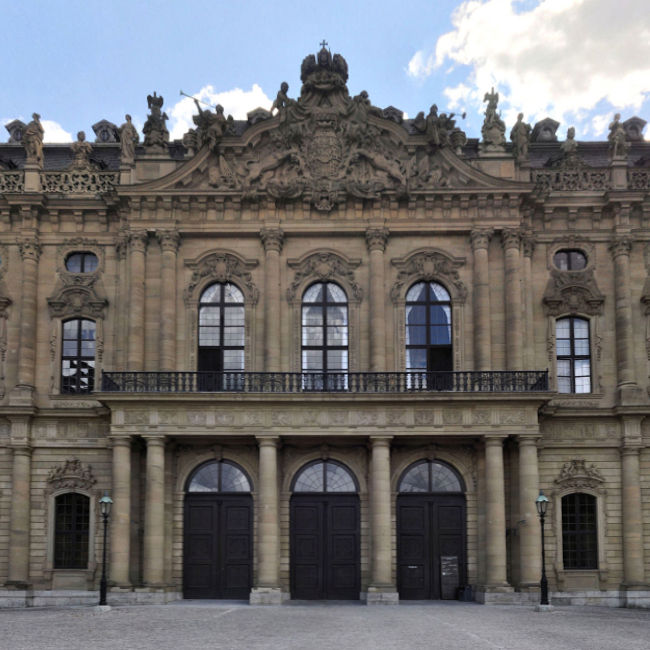Wurzburg Residence. The Würzburg Residence is a palace in Würzburg, Germany. Johann Lukas von Hildebrandt and Maximilian von Welsch, representatives of the Austrian/South German Baroque style, were involved in the construction, as well as Robert de Cotte and Germain Boffrand, who were followers of the French Style. Balthasar Neumann, court architect of the Bishop of Würzburg, was the principal architect of the Residence, which was commissioned by the Prince-Bishop of Würzburg Johann Philipp Franz von Schönborn and his brother Friedrich Carl von Schönborn in 1720, and completed in 1744. The Venetian painter Giovanni Battista Tiepolo, assisted by his son, Domenico, painted frescoes in the building. Interiors considered masterworks of Baroque/Rococo or Neoclassical architecture and art include the grand staircase, the chapel, and the Imperial Hall. The building was reportedly called the largest parsonage in Europe by Napoleon. It was heavily damaged by Allied bombing during World War II, and restoration has been in progress since 1945. Since 1981, the Residence has been a UNESCO World Heritage Site. The Prince-Bishops of Würzburg resided in the Marienberg Fortress on a hill west of the Main river until the early 18th century. Johann Philipp Franz von Schönborn moved the court to a palace erected in 1701-4, the predecessor of the Residence. However, the rather small palace did not, in his opinion, measure up to his position as an absolute monarch-he was looking for something comparable to the Palace of Versailles or Schönbrunn Palace. Having won a sum of 600,000 fl. in a court case in the year of his accession, he used the funds to undertake a building project that would proclaim his political standing to all. In this, he was eagerly supported by two relatives, his uncle the Archbishop of Mainz and Elector of Mainz, Lothar Franz von Schönborn and his brother Friedrich Carl von Schönborn, from 1704 to 1734 Imperial Vice-Chancellor in Vienna. Both supplied ideas and, crucially, artists from their circles. Friedrich Carl had met Hildebrandt in Vienna during the construction of the Belvedere. The foundation stone was laid on 22 May 1720. The construction started with the north block. However, Johann Phillip Franz' successor, Prince-Bishop Christoph Franz von Hutten had no great interest in building such an enormous palace. He only wanted the northern block to be finished. This construction was concluded in the year of his death. All other works ceased. In the year 1730, however, under Prince-Bishop Friedrich Carl von Schönborn, work on the south block began once more. In 1732-3, the front of the Cour d'honneur was completed. From 1735 onwards, the work on the central building took place with the participation of Lucas von Hildebrandt. In 1737, the main staircase by Balthasar Neumann was constructed. The garden front was completed in 1740 and the whole shell in December 1744. Neumann was mostly responsible for the Residence's town front, while Hildebrandt's work dominated on the garden side. The four interior courts of the side wings were an idea of von Welsch. The completion of the vaulted ceilings over the Emperor's Hall and the White Hall took place in 1742; the vault over the staircase in 1743. At the same time, the decorations of the Court Chapel were realized and its consecration performed in 1743. From 1740-5, the southern Kaiserzimmer and the Mirror Cabinet were decorated by ornamental carver Ferdinand Hundt, by Johann Wolfgang van der Auvera, Antonio Giuseppe Bossi and Johann Rudolf Byss. Bossi also created the stucco-work in the White Hall during the years 1744-5. Under the rule of Prince-Bishop Anselm Franz von Ingelheim, all building work on the Residence ceased once again. After his death, once Karl Philipp von Greifenclau zu Vollraths became Prince-Bishop, he ordered a resumption of construction. In the same year, Antonio Bossi completed the stucco-work in the Garden Hall, the painting of which was finished in the next year. In 1750, Lorenz Jakob Mehling, a merchant at Venice, sent Giovanni Battista Tiepolo to the bishopric residence, after the painter Giuseppe Visconti had failed. Giovanni Battista Tiepolo, assisted by his sons, decorated the Imperial Hall and the ceiling above the staircase with frescoes in the early 1750s. In 1753, Balthasar Neumann died. Under Prince-Bishop Adam Friedrich von Seinsheim, Materno and Ludovico Bossi created the stucco-work decoration over the staircase and in the first and second guest rooms of the northern Kaiserzimmer between 1769 and 1772. At the same time, the Green Lacquered Room and the Neoclassical Fürstensaal were finished.
more...



